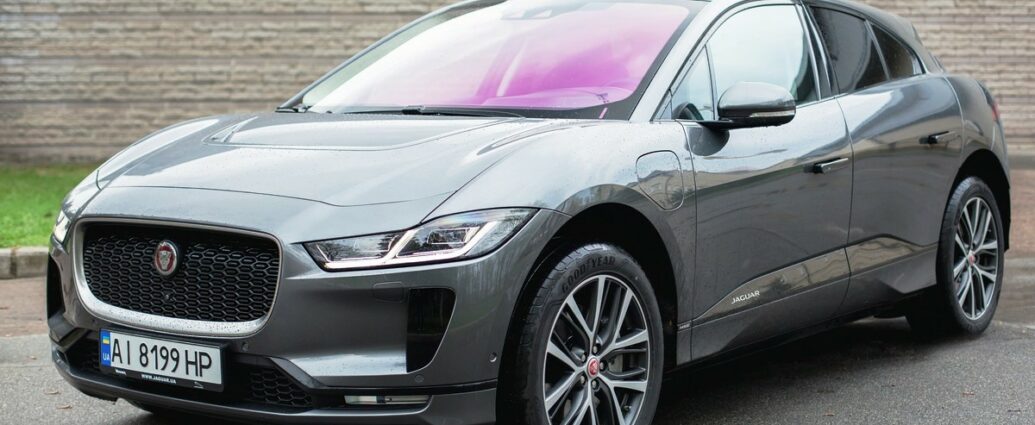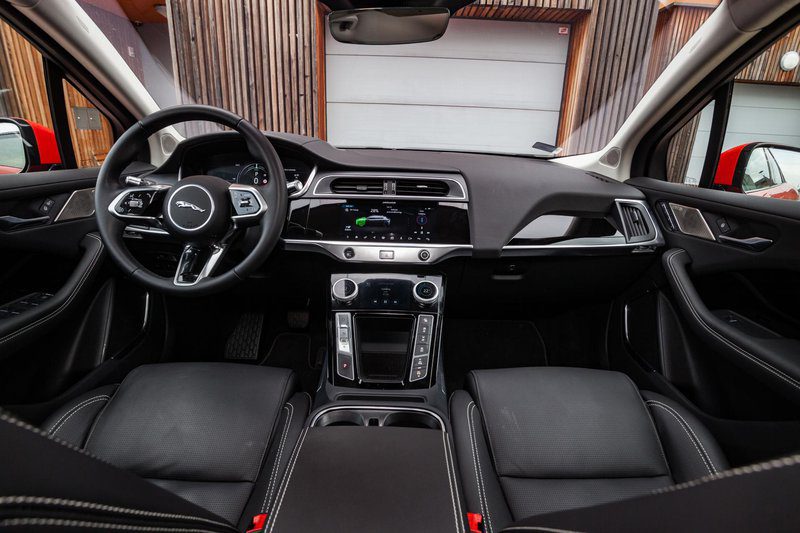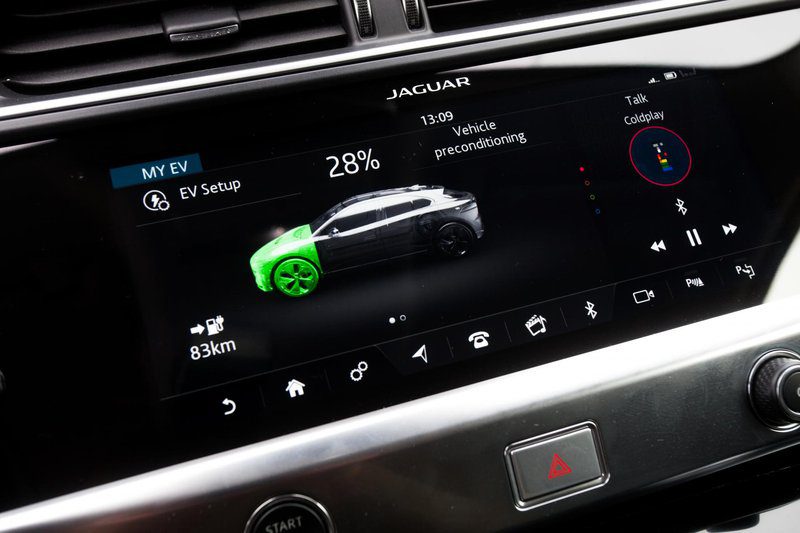
Test: Jaguar I-Pace HSE 400HP AWD (2019) // Edini!
Content
You do not believe the words in the introduction? Let's get a look. In the higher-end electric vehicle segment, which is designed to take on the task of being the main car in the house, Jaguar currently has only three competitors. The Audi e-tron and Mercedes-Benz EQC are great cars, but they were built by "strength" on the platforms of other home models. Tesla? Tesla is a set of components that can be found in many cars from other brands.
From a Mercedes steering wheel to - beware - windshield wiper motors "taken" from American Kenworth trucks. At Jaguar, the story began on paper and continued down the longest path it takes for a new model to see the light of day: design, development and production. And all this was subordinated to the creation of a car optimally adapted to the electric power plant.
Already the design suggests that the I-Pace is an unconventional vehicle. Long hood? Why do we need it if there is no huge eight-cylinder engine in the bow? Wouldn't it be better to use those inches inside? Even more interesting is the design, which is difficult to attribute to a crossover, but if the side lines are clearly a coupe, and the hips are emphasized, like a supercar. Where should it be placed then? The Jaguar I-Pace knows how to be everything, and this is its strongest card. Lifting the body with the help of air suspension instantly changes its character.

From a lowered sports car with 20-inch wheels placed at the edges of the car, to an SUV that is 10 centimeters taller, able to overcome even water obstacles up to half a meter deep. And in the end: design, even if it is subordinate to design and functionality, works. The car is attractive, harmonious and simply bold and futuristic, reflecting its focus on the technology of the future, as well as playing a small card of sentimentality towards the classic curves of former Jaguars. Except for hidden door handles, which make getting into the car more difficult than easy, due to some "wav-effect".
As stated, the benefits of electric vehicle design allow for better use of interior space. While the I-Pace has a rather coupe-like shape, in terms of spaciousness, this is not known at all. Internal inches are generously dosed, so there should be no complaints from the driver and the other four passengers. If you have images of old Jaguar interiors in mind, the I-Pace's interior will seem completely out of the context of the brand. But behind such a bold decision to completely design a car that marks the future of the brand, only the fact that here they elude the classics follows. And this is correct, because in fact everything "fits".

The driver environment is fully digitized and divided into three main sections. Instead of classic instruments, there is a huge 12,3-inch digital screen, the main screen of the infotainment system is 10-inch, and below it is an auxiliary 5,5-inch screen. The latter somehow ensures that intuition is greatly improved, as shortcuts to the tasks we use most in the car can be quickly recalled. Here we mean mainly the control of the air conditioner, radio, telephone, etc.
Even otherwise, the interface of the main infotainment system is beautifully designed and easy to use. Especially if the user sets the labels of his choice on the first page and always keeps them at hand. To obtain the required data on the meters, additional adjustment is required. There, the interfaces are more complicated, and steering the rotor on the steering wheel is also not the easiest. It is logical that such a strong digitization of the environment creates inevitable problems: it shines brightly on all screens, and they also quickly become a magnet for dust and fingerprints. Speaking of criticism, we were missing a phone case that supported wireless charging, something that is slowly becoming the standard even for cars that aren't as digitally advanced as the I-Pace.
Of course, it should be added that the novelty is equipped with a wide range of security systems. We do not even doubt the good functioning of the passive safety elements, but we can say that with some assistance systems this can still be a step towards competition. Here we think mainly about radar cruise control and lane keeping. The duo can easily afford a mistake, a rude reaction, unnecessary inhibition, etc.
Drive technology? At Jaguar, nothing was left to chance when it came to impressive performance. Two motors, one for each axle, offer 294 kW and 696 Nm of torque. And not quite some torque as we wait for the engine to wake up. From scratch. Straightaway. All this is enough for a good two-ton steel cat to jump to a hundred in just 4,8 seconds. The flexibility is even more impressive, as the I-Pace only takes two seconds to jump from 60 to 100 kilometers per hour. And that is not all. When you press the pedal in Sport mode at about 100 kilometers per hour, the I-Pace beeps like a student driver LPP bus in practice. All this happens without the accompaniment of aggressive and disturbing sounds. Just a little wind on the body and rustling under the wheels. What is great when you want to ride calmly and comfortably. And here the I-Pace is great too. There was no compromise in comfort due to electrification. Do you want seat heating or cooling? There is. Do I need to instantly cool or heat the passenger compartment? No problem.

To all consumers, a small snack to a lithium-ion battery with a capacity of 90 kilowatt-hours. Well, if we ruled out all those consumers and were careful with our right foot, a Jaguar like this could go 480 kilometers. But in reality, at least with the flow from our normal circle, the range is from 350 to a maximum of 400 kilometers. As long as you have the right charging infrastructure, I-Pace's fast charging shouldn't be a problem. At the moment, we have only one charging station in Slovenia that could charge such a Jaguar from 0 to 80 percent with 150 kilowatts in just forty minutes. Most likely, you will plug it into a 50 kilowatt charger, where it will charge up to 80 percent in 85 minutes. So at home? If you have a 16 amp fuse in your home outlet, it will need to be left on all day long (or longer). If you're thinking about a home charging station, with a built-in 7 kilowatt charger, you'll need a little less time - a good 12 hours, or fast enough to make up for the missing battery reserves overnight.
The current European Car of the Year justifies its title by being the only car in the automotive market at such a high level that combines cutting-edge technology, performance, practicality and, in the end, heritage. Already for this audacity, which allowed him to escape some of the traditional shackles and look boldly into the future, he deserves a reward. However, if the final product is that good, then there is no doubt that the award is well deserved. Is it easy to live with such a machine? We would be lying if we said that we should not obey him even a little, or even adapt to everyday life. Since its job is to be the main machine in the house, battery life will always be a problem to be on the wall before planning a route. But if your life is in this range, then there is no doubt that such an I-Pace is the right choice.
Jaguar I-Pace HSE 400HP AWD (2019)
Basic data
| Sales: | Auto Active Ltd. |
|---|---|
| Test model cost: | 102.000 EUR € |
| Base model price with discounts: | € 94,281 XNUMX € |
| Test model price discount: | 102.000 EUR € |
| Power: | 294kW (400 KM) |
| Acceleration (0-100 km / h): | 4,9 ss |
| Maximum speed: | 200 km / h km / h |
| Mixed flow ECE: | 25,1 kWh / 100 km l / 100 km |
| Guarantee: | General warranty 3 years or 100.000 8 km, 160.000 years or 70 XNUMX km and XNUMX% battery life. |
| Systematic review | 34.000 km / 24 |
Cost (up to 100.000 km or five years)
| Regular services, works, materials: | € 775 XNUMX € |
|---|---|
| Fuel: | € 3.565 XNUMX € |
| Tires (1) | € 1.736 XNUMX € |
| Loss of value (within 5 years): | 67.543 XNUMX € |
| Compulsory insurance: | 3.300 XNUMX € |
| CASCO INSURANCE (+ B, K), AO, AO + | 14.227 ( |
| Calculate the cost of auto insurance | |
| Buy up | 91.146 € 0,91 (value for XNUMX km: XNUMX € / km €) |
Technical information
| engine: | 2 electric motors - front and rear transversely - system output 294 kW (400 hp) at np - maximum torque 696 Nm at np |
|---|---|
| Battery: | 90 kWh |
| Energy transfer: | engines driven by all four wheels - 1-speed manual transmission - np ratios - np differential - rims 9,0 J × 20 - tires 245/50 R 20 H, rolling range 2,27 m. |
| Capacity: | top speed 200 km/h - acceleration 0-100 km/h 4,8 s - power consumption (WLTP) 22 kWh / 100 km - electric range (WLTP) 470 km - battery charging time 7 kW: 12,9 h (100%), 10 (80%); 100 kW: 40 min. |
| Transportation and suspension: | crossover - 5 doors, 4 seats - self-supporting body - front single suspension, air suspension, triangular cross rails, stabilizer - rear multi-link axle, air springs, stabilizer - front disc brakes (forced cooling), rear disc brakes (forced-cooled), ABS, parking electric brake on the rear wheels (switching between seats) - steering wheel with rack and pinion, electric power steering, 2,5 turns between extreme points. |
| Mass: | empty vehicle 2.208 kg - permissible total weight 2.133 kg - permissible trailer weight with brake: np, without brake: np - permissible roof load: np |
| External dimensions: | length 4.682 mm – width 2.011 mm, with mirrors 2.139 1.565 mm – height 2.990 mm – wheelbase 1.643 mm – track front 1.663 mm – rear 11,98 mm – ground clearance XNUMX m. |
| Inner dimensions: | longitudinal front 890-1.110 mm, rear 640-850 mm - front width 1.520 mm, rear 1.500 mm - head height front 920-990 mm, rear 950 mm - front seat length 560 mm, rear seat 480 mm - steering wheel ring diameter 370 mm |
| Box: | 656 + 27 l |
Our measurements
| T = 23 ° C / p = 1.063 mbar / rel. vl. = 55% / Tires: Pirelli Scorpion Winter 245/50 R 20 H / Odometer status: 8.322 km | |
| Acceleration 0-100km: | 4,9 ss |
|---|---|
| 402m from the city: | 13,5 ss ( 149 km / h / km) |
| Maximum speed: | 200 km / h km / h |
| Fuel consumption according to the standard scheme: | 25,1 kWh / 100 km l / 100km |
| Braking distance at 130 km / h: | 61,0 mm |
| Braking distance at 100 km / h: | 39,6 mm |
| Noise at 90 km / h | 57 dBdB |
| Noise at 130 km / h | 61 dBdB |
Overall rating (479/600)
Jaguar's mind twist turned out to be the right decision with the I-Pace. Those who dream of other times and of some other Jaguars need to come to terms with the fact that it's time to progress. The I-Pace is interesting, distinctive, unique and technologically advanced enough to set the standard for the generation of cars that are just appearing on our roads.
Cab and trunk (94/110)
The EV-adapted design allows for a lot of space inside. The practicality of storage surfaces hurts at some point.
Comfort (102
/ 115)Extremely sealed cab, efficient heating and cooling and excellent ergonomics. I-Pace feels great.
Transmission (62
/ 80)The abundance of torque available across all operating ranges provides exceptional flexibility. We have nothing to complain about battery and charging as long as the charging infrastructure is in good shape.
Driving performance (79
/ 100)Despite the winter tires on the test car (?) In October, the situation was satisfactory. Good air suspension helps.
Security (92/115)
Security systems are not discussed and help can cause some problems. The rear view is slightly limited due to the small rearview mirrors.
Economy and environment
Considering that they did not save on comfort, the energy consumption is very tolerable. It is known that the car was created as an electric car.
We praise and reproach
Automotive design
Drive technology
Interior soundproofing
Functionality and spaciousness of the cabin
Comfort
Field objects
Radar cruise control operation
Hiding door handles
Glare on screens
Insufficient rearview mirrors
It doesn't have wireless phone charging